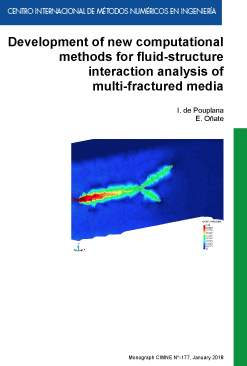Development of new computational methods for fluid-structure interaction analysis of multi-fractured media
FREE!
Editorial: CIMNE
Year of publication: 2018
Pages: 195
Editorial: CIMNE
Year of publication: 2018
Pages: 195
Description
The objective of this monograph is the derivation and implementation of a robust Finite Element formulation for the solution of solid-pore fluid coupled problems in multi-fractured porous media.
A coupled displacement-pore pressure FEM formulation for solving solid-pore fluid interaction problems is first introduced. The interaction between both components is governed by two equations: the balance of momentum for the mixture solid-fluid and the mass balance for the pore fluid.
Under nearly undrained-incompressible conditions, such formulation suffers from instability problems because of the violation of Babuska-Brezzi conditions. In order to work with elements of equal order interpolation for the displacement and pore pressure, the formulation is stabilized by means of the Finite Increment Calculus method (FIC). The FIC-stabilized formulation is tested against stable elements with a higher order interpolation for the displacement field in 2D and 3D examples.
Continuum damage mechanics is the basis of the crack growth strategy for the proposed fracture propagation technique. The strain softening models used for quasi-brittle materials favour spurious strain localization and ill-posedness of the boundary value problem if the damage variable only depends on the strain state at the point under consideration.
An integral-type non-local damage model associated to a characteristic length parameter is presented as a method to control the size of the fracture process zone and fully regularize the problem. Two examples are solved assessing the robustness of the model in front of changes in the spatial discretization.
Quasi-zero-thickness interface elements are formulated to represent discontinuities in the porous domain. A bilinear cohesive fracture model is used to describe its mechanical behaviour, and a formulation derived from the cubic law models the fluid flow through the crack.
Finally, a new methodology for the simulation of fracture propagation processes in saturated porous media is presented. The non-local damage model is used in conjunction with the interface elements to predict the degradation pattern of the domain and insert new fractures followed by remeshing. Fluid-driven fracture propagation examples in 2D and 3D are presented to illustrate the accuracy of the proposed technique.
Additional information
| Year of Publication | 2018 |
|---|---|
| format | Monograph |

